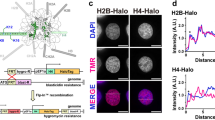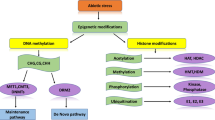Abstract
The promoter of the Drosophila hsp26 gene contains two DNase I-hypersensitive (DH) sites and a positioned nucleosome, and this open chromatin structure is required for heat-inducible expression. Histone acetylation modification participates in transcriptional regulation of genes by affecting the status of chromatin remodeling. In this study, we investigated the roles of histone acetylation modification on hsp26 expression in Drosophila. We showed that the histone deacetylase inhibitor (HDI) treatments of Drosophila larvae induced the histone H3 hyperacetylation at the promoter DH sites, which facilitated the binding of heat shock factor (HSF) to heat shock element (HSE). This resulted in a promoted transcription of hsp26 gene following the heat shock, and further increased the inducible expression of hsp26 gene. On the contrary, the HDI-induced histone H3 hyperacetylation in the middle nucleosome decreased the basal expression of hsp26 gene under the normal growth conditions. In addition, by following up the heat-shock time course, we showed that the histone acetylation level at the DH sites exhibited a drop-raise-drop change, while that at the positioned nucleosome underwent a raise-drop-raise-drop switchover. These results demonstrated the distinct roles played by histone acetylation modification in hsp26 gene basal and inducible expression regulation in D. melanogaster







Similar content being viewed by others
Abbreviations
- Hsp:
-
Heat shock protein
- HDI:
-
Histone deacetylase inhibitor
- TSA:
-
Trichostatin A
- BuA:
-
Sodium butyrate
- HSF:
-
Heat shock factor
- HAT:
-
Histone acetyltransferase
- HDAC:
-
Histone deacetylase
- GAF:
-
GAGA factor
- ChIP:
-
Chromatin immunoprecipitation
References
Lis JT, Wu C (1994) Transcriptional regulation of heat shock gene. In: Conaway RC, Conaway JW (eds) Transcription: mechanisms and regulation. Raven Press, New York, NY, pp 459–475
Aalfs JD, Kingston RE (2000) What does “chromatin remodeling” mean? Trends Biochem Sci 25:548–555
Albright SR, Tjian R (2000) TAFs revisited: more data reveal new twists and confirm old ideas. Gene 242:1–13
Pugh BF (2000) Control of gene expression through regulation of the TATA-binding protein. Gene 255:1–14
Morimoto RI, Sarge KD, Abravaya K (1992) Transcriptional regulation of heat shock genes. A paradigm for inducible genomic responses. J Biol Chem 267:21987–21990
Lis JT (1998) Promoter-associated pausing in promoter architecture and post-initiation transcriptional regulation. Cold Spring Harbor Symp. Quant Biol 53:347–356
Francis NJ, Kingston RE (2001) Mechanisms of transcriptional memory. Nat Rev Mol Cell Biol 2:409–421
Morimoto RI (1998) Regulation of the heat shock transcriptional response: cross talk between a family of heat shock factors, molecular chaperones, and negative regulators. Genes Dev 12:3788–3796
Lu Q, Wallrath LL, Elgin SC (1995) The role of a positioned nucleosome at the Drosophila melanogaster hsp26 promoter. EMBO J 14:4738–4746
Smith ST, Petruk S, Sedkov Y et al (2004) Modulation of heat shock gene expression by the TAC1 chromatin-modifying complex. Nat Cell Boil 6:162–167
Li Q, Herrler M, Landsberger N et al (1998) Xenopus NF-Y pre-sets chromatin to potentiate p300 and acetylation-responsive transcription from the Xenopus hsp70 promoter in vivo. EMBO J 17:6300–6315
Nightingale KP, Wellinger RE, Sogo JM et al (1998) Histone acetylation facilitates RNA polymerase II transcription of the Drosophila hsp26 gene in chromatin. EMBO J 17:2865–2876
Ovakim DH, Heikkila JJ (2003) Effect of histone deacetylase inhibitors on heat shock protein gene expression during Xenopus development. Genetics 36:88–96
Ahringer J (2000) NuRD and SIN3: histone deacetylase complexes in development. Trends Genet 16:351–356
Ng HH, Bird A (2000) Histone deacetylases: silencers for hire. Trends Biochem Sci 25:121–126
Johnstone RW (2002) Histone-deacetylase inhibitors: novel drugs for the treatment of cancer. Nat Rev Drug Discov 1:287–299
Zhao Y, Lu J, Sun H et al (2005) Histone acetylation regulates both transcription initiation and elongation of hsp22 gene in Drosophila. Biochem Biophys Res Commun 326:811–816
Zhao Y, Chen X, Sun H et al (2006) Effect of histone deacetylase inhibitors on hsp70 gene transcription regulation in Drosophila. Cell Res 16:566–576
Giancotti V, Russo E, De Cristini F et al (1984) Histone modification in early and late Drosophila embryos. Biochem J 218:321–329
Zhao Y, Sun H, Lu J et al (2005) Lifespan extension and elevated hsp gene expression in Drosophila caused by histone deacetylases inhibitors. J Exp Biol 208:697–705
Marks PA, Richon VM, Rifkind RA (2000) Histone deacetylase inhibitors: inducers of differentiation or apoptosis of transformed cells. J Natl Cancer Inst 92:1210–1216
Yoshida M, Kijima M, Akita M et al (1990) Potent and specific inhibition of mammalian histone deacetylase both in vivo and in vitro by trichostatin A. J Biol Chem 265:17174–17179
Sealy L, Chalkley R (1978) The effect of sodium butyrate on histone modification. Cell 14:115–121
Jenuwein T, Allis CD (2001) Translating the histone code. Science 293:1074–1080
Shopland LS, Hirayoshi K, Fernandes M et al (1995) HSF access to heat shock elements in vivo depends critically on promoter architecture defined by GAGA factor, TFIID, and RNA polymerase II binding sites. Genes Dev 9:2756–2769
Leibovtch BA, Lu Q, Benjamin LR et al (2002) GAGA factor and the TFIID complex collaborate in generating an open chromatin structure at the Drosophila melanogaster hsp26 promoter. Mol Cell Biol 22:6148–6157
Tsukiyama T, Wu C (1995) Purification and properties of an ATP-dependent nucleosome remodeling factor. Cell 83:1011–1020
Tsukiyama T, Becker PB, Wu C (1994) ATP-dependent nucleosome disruption at a heat-shock promoter mediated by binding of GAGA transcription factor. Nature 367:525–532
Acknowledgments
We would like to thank Professors J.T. Lis (Department of Molecular Biology and Genetics, College of Agriculture and life Sciences, Cornell University) and C. Wu (Laboratory of Biochemistry, NCI, NIH) for providing antibodies. This work was supported by grants from The National Basic Research Program of China (2006CB910506, 2005CB522404) and from the Program for Changjiang Scholars and Innovative Research Team (PCSIRT) in Universities (IRT0519).
Author information
Authors and Affiliations
Corresponding author
Rights and permissions
About this article
Cite this article
Zhao, Y., Lu, J., Sun, H. et al. Roles of histone acetylation modification in basal and inducible expression of hsp26 gene in D. melanogaster . Mol Cell Biochem 306, 1–8 (2007). https://doi.org/10.1007/s11010-007-9547-x
Received:
Accepted:
Published:
Issue Date:
DOI: https://doi.org/10.1007/s11010-007-9547-x




